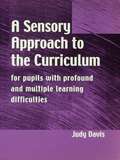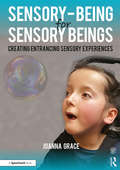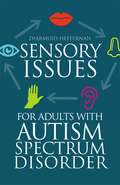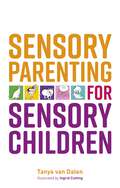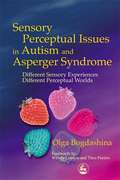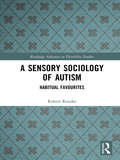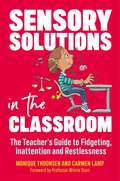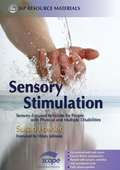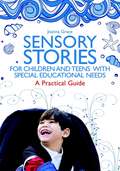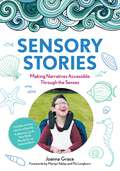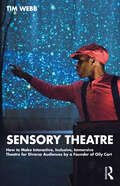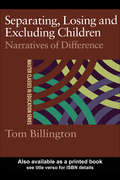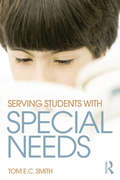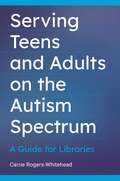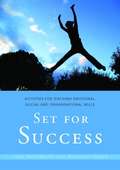- Table View
- List View
A Sensory Approach to the Curriculum: For Pupils with Profound and Multiple Learning Difficulties
by Judy DavisWritten by a teacher with many years of experience with pupils with PMLD, this book offers a well-tried approach to delivering the curriculum, with particular emphasis on the core subjects. It aims to complement and supplement existing material and provides a useful resource for busy teachers.
A Sensory Approach to the Curriculum: For Pupils with Profound and Multiple Learning Difficulties
by Judy DavisWritten by a teacher with many years of experience with pupils with PMLD, this book offers a well-tried approach to delivering the curriculum, with particular emphasis on the core subjects. It aims to complement and supplement existing material and provides a useful resource for busy teachers.
Sensory-Being for Sensory Beings: Creating Entrancing Sensory Experiences
by Joanna GraceSensory-being: the enveloping of natural presentness and awareness in an unfolding sensory moment. Sensory Beings: people whose experience of the world, and meaning within it, is primarily sensory. Often these are people who do not have access to language. If you support someone who understands the world in a primarily sensory way, for example someone with PMLD or later stage dementia, you will recognise that they often face periods of time in which they are left without an activity they can access. This unique, practical guide helps you to plan and deliver sensory activities that lead people into a calm, focused state. You are even invited to let the person you support lead you into a state of sensory focus. Written by a leading sensory specialist this book will help you to: View the world as the person you support may view it, and identify times when a sensory-being activity may be appropriate. Understand how to select and create the most engaging, low cost, sensory foci to suit the specific needs of the individuals in your care. Effectively facilitate sensory-being sessions from start to finish so that the people you care for receive the full and many benefits of calm, focused time. Tried and tested in a diverse range of settings prior to publication, these techniques and practical tools have already helped many people provide an enriched experience of life for those in their care. Throughout the book you will find numerous case studies and insights from parents, carers, special school practitioners, therapists, research institutions and more so that you can benefit from this broad body of experience.
Sensory Issues for Adults with Autism Spectrum Disorder
by Luke Beardon Diarmuid HeffernanUnderstanding sensory issues can be the key to overcoming them. Using this practical guide, individuals with Autism Spectrum Disorders (ASDs) can begin to understand their sensory difficulties and learn how to create a tailored plan for overcoming specific everyday challenges. Learn how the senses work and how sensory systems can function differently for people with ASD, leading to sensory perceptual issues. What are the difficulties that can arise at work, college, home, or in public or cyber spaces? Practical strategies and creating a unique 'sensory plan', based on frequently encountered environments and situations, will help any adult with ASD to overcome these sensory difficulties.
Sensory Issues for Adults with Autism Spectrum Disorder (PDF)
by Diarmuid Heffernan Luke BeardonUnderstanding sensory issues can be the key to overcoming them. Using this practical guide, individuals with Autism Spectrum Disorders (ASDs) can begin to understand their sensory difficulties and learn how to create a tailored plan for overcoming specific everyday challenges. Learn how the senses work and how sensory systems can function differently for people with ASD, leading to sensory perceptual issues. What are the difficulties that can arise at work, college, home, or in public or cyber spaces? Practical strategies and creating a unique 'sensory plan', based on frequently encountered environments and situations, will help any adult with ASD to overcome these sensory difficulties.
Sensory Parenting for Sensory Children
by Tanya Van DalenWhen your child dysregulates, half the battle is managing your own response. In the moment, you're at the mercy of many competing feelings: embarrassment, fear, panic, exhaustion. Being able to recognise your own triggers and behaviours in order to stay calm and provide the best support to your child, is not a skill that comes easily. Helping parents and carers to reflect on themselves, think about how they manage sensory meltdowns and give them some simple ideas on how to manage their own emotions in order to help their child, this is a short and simple guide for those that parent or care for a child with sensory needs, or a sensory processing disorder (SPD). Drawing on Porges' polyvagal theory, and using easy-to-follow animal analogies, this will empower parents to build empathy for their child, and themselves.
Sensory Parenting for Sensory Children
by Tanya Van DalenWhen your child dysregulates, half the battle is managing your own response. In the moment, you're at the mercy of many competing feelings: embarrassment, fear, panic, exhaustion. Being able to recognise your own triggers and behaviours in order to stay calm and provide the best support to your child, is not a skill that comes easily. Helping parents and carers to reflect on themselves, think about how they manage sensory meltdowns and give them some simple ideas on how to manage their own emotions in order to help their child, this is a short and simple guide for those that parent or care for a child with sensory needs, or a sensory processing disorder (SPD). Drawing on Porges' polyvagal theory, and using easy-to-follow animal analogies, this will empower parents to build empathy for their child, and themselves.
Sensory Perceptual Issues In Autism And Asperger Syndrome: Different Sensory Experiences, Different Perceptual Worlds
by Olga Bogdashina Wendy LawsonThe ability to perceive accurately stimuli in the environment is basic to many areas of academic, communicative and social functioning. Although people with autism live in the same physical world and deal with the same `raw material' their perceptual world turns out strikingly different from that of non-autistic people. It is widely reported that autistic people have `unusual' sensory perceptual experiences that may involve hypo- and hypersensitivity, fluctuation between different `volumes' of perception and difficulty interpreting a sense. In this book, Olga Bogdashina attempts to define the role of sensory perceptual problems in autism identified by autistic individuals themselves. Often ignored by many professionals, this is one of the main problems highlighted by autistic individuals. This book singles out possible patterns of sensory experiences in autism and the cognitive differences caused by them. The final chapters are devoted to assessment and intervention issues with practical recommendations for selecting appropriate methods and techniques to eliminate the problems and enhance the strengths. Sensory Perceptual Issues in Autism and Asperger Syndrome is vital to teachers and other professionals working with autistic individuals to fully comprehend sensory perceptual differences in autism. This book will help readers select appropriate methods for dealing with autistic individuals. In addition, parents of autistic individuals and autistic individual themselves will find the information will enable them to initiate relevant strategies and environmental changes to facilitate more effective learning.
A Sensory Sociology of Autism: Habitual Favourites (Routledge Advances in Disability Studies)
by Robert RourkeThis innovative book places the sensory experiences of autistic individuals within a sociological framework. It instigates new discussions around sensory experience, autism and how disability and ability can be reconceived. Autism is commonly understood to involve social and communication difficulties. Less commented upon is the sensory challenges faced by those with autism. Sociology is no different, focusing on communication and neglecting the sensory dimensions of experience. Sensory experiences and relations are central to how we understand and navigate through the natural and social worlds, and mediate our interactions with other people, objects and spaces. In this book, the author explores how these processes are affected by the favourite activities of autistic people. With real-life case studies and cutting-edge research, this book will be useful to students, autistic people, advocates and carers, disability studies researchers and sociologies of disability and the senses.
A Sensory Sociology of Autism: Habitual Favourites (Routledge Advances in Disability Studies)
by Robert RourkeThis innovative book places the sensory experiences of autistic individuals within a sociological framework. It instigates new discussions around sensory experience, autism and how disability and ability can be reconceived. Autism is commonly understood to involve social and communication difficulties. Less commented upon is the sensory challenges faced by those with autism. Sociology is no different, focusing on communication and neglecting the sensory dimensions of experience. Sensory experiences and relations are central to how we understand and navigate through the natural and social worlds, and mediate our interactions with other people, objects and spaces. In this book, the author explores how these processes are affected by the favourite activities of autistic people. With real-life case studies and cutting-edge research, this book will be useful to students, autistic people, advocates and carers, disability studies researchers and sociologies of disability and the senses.
Sensory Solutions in the Classroom: The Teacher's Guide to Fidgeting, Inattention and Restlessness
by Carmen Lamp Monique ThoonsenEvery teacher knows them - the students who are continuously balancing on their chair legs or who prefer to hide in their hoodies all day long. These students are using all kinds of tricks to be able to stay focused, as they are under- or overresponsive to sensory input and trying to restore their balance.Children who struggle with processing sensory input can experience a wide range of symptoms, including hypersensitivity to sound, sight and touch, poor fine motor skills and easy distractibility. Using this accessible, science-based guide, school staff can support these students by understanding their symptoms and how they impact their learning. Teachers can learn to look at students in a different way: through so-called 'SPi glasses', introduced in the book. With these glasses on, you learn to recognize behaviours linked to sensory processing and respond quickly, easily and with more understanding, without using a diagnosis, medication or therapy. The techniques provided help children feel settled and soothed at school, enabling them to learn and communicate better. Creating the perfect learning environment for all students - a sensory supportive classroom - this tried and tested guide is an essential tool for teachers (with or without prior knowledge of SPD), to better support and understand their students and their sensory needs.
Sensory Stimulation: Sensory-Focused Activities for People with Physical and Multiple Disabilities (PDF)
by Susan FowlerWe learn about the world constantly through our senses and by interacting with it. Children explore and play in different environments and in doing so they find out what burns them or hurts them, what can be eaten, which things smell nice and what different sounds signify. This process of exploration and learning continues throughout our lives. Because of physical, sensory or intellectual disabilities many people have not had the same opportunities to explore and interact with their environment. Sensory-focused activities are designed to provide environments in which people with disabilities can have the opportunity to use their senses to learn about and interact more meaningfully with the world. This photocopiable resource provides the reader with a step-by-step approach to organising sensory-focused activities for carers and other professionals working with people with physical, multiple or complex disabilities. Importantly, it also presents information on sensory stimulation within a framework that embraces the person's daily environment. Activity ideas are based around food, drink, personal and household care and crafts and are kept simple so they can be slotted into daily routine with minimum disruption. Assessment forms and checklists will help carers and support staff to monitor and understand their clients' needs and progress.
Sensory Stories for Children and Teens with Special Educational Needs: A Practical Guide
by Joanna GraceSensory Stories are short stories of a few lines which are brought to life through a selection of meaningful sensory experiences. They are particularly beneficial for students with Sensory Processing Disorder (SPD), profound and multiple learning difficulties (PMLD), autism spectrum disorders (ASD) and other special educational needs (SEN). For children with PMLD, Sensory Stories can open up new avenues for communication and inclusive learning. For students with SPD and ASD, they offer a fun way of encountering sensory experiences and triggers in a safe, repetitive way, which over time can help to reduce associated anxieties. This accessible guide offers teachers, other professionals working with students with SEN and parents with a complete step-by-step guide to creating and using Sensory Stories effectively. Aiming to make Sensory Stories affordable and accessible to schools and parents alike by using everyday items found in the classroom and home, Joanna Grace provides original, ready-to-use Sensory Stories with accompanying lesson plans, games and activities and adaptations for different abilities and diagnoses. Written by an experienced SEN consultant and sensory learning specialist, this is unique and essential reading for teachers, other professionals and parents wishing to introduce the many benefits of multi-sensory storytelling to children in their care.
Sensory Stories for Children and Teens with Special Educational Needs: A Practical Guide (PDF)
by Joanna GraceSensory Stories are short stories of a few lines which are brought to life through a selection of meaningful sensory experiences. They are particularly beneficial for students with Sensory Processing Disorder (SPD), profound and multiple learning difficulties (PMLD), autism spectrum disorders (ASD) and other special educational needs (SEN). For children with PMLD, Sensory Stories can open up new avenues for communication and inclusive learning. For students with SPD and ASD, they offer a fun way of encountering sensory experiences and triggers in a safe, repetitive way, which over time can help to reduce associated anxieties. This accessible guide offers teachers, other professionals working with students with SEN and parents with a complete step-by-step guide to creating and using Sensory Stories effectively. Aiming to make Sensory Stories affordable and accessible to schools and parents alike by using everyday items found in the classroom and home, Joanna Grace provides original, ready-to-use Sensory Stories with accompanying lesson plans, games and activities and adaptations for different abilities and diagnoses. Written by an experienced SEN consultant and sensory learning specialist, this is unique and essential reading for teachers, other professionals and parents wishing to introduce the many benefits of multi-sensory storytelling to children in their care.
Sensory Stories to Support Additional Needs: Making Narratives Accessible Through the Senses
by Joanna GraceSensory Stories are short stories of a few lines which are brought to life through a selection of meaningful sensory experiences. They are particularly beneficial for people with Sensory Processing Disorder (SPD), Profound and Multiple Learning Difficulties (PMLD) and Autistic children or adults. Sensory stories are perfect for introducing new sensory environments in a safe, interactive way to help reduce associated anxieties and open up new avenues for communication and play.This updated edition is packed with original ready-to-use sensory stories, including 5 additional guest sensory stories by authors from around the world and your very own story template to create a sensory experience personalised for each person. With exclusive 'how to' video content and digital lesson plans, this book is the essential tool for introducing the transformative multi-sensory storytelling method into your home, classroom or group setting.Using everyday items and step-by-step instructions to make incorporating sensory stories accessible and simple, it has never been easier to create inclusive and fun sensory experiences to enhance the lives of those with additional needs.
Sensory Stories to Support Additional Needs: Making Narratives Accessible Through the Senses
by Joanna GraceSensory Stories are short stories of a few lines which are brought to life through a selection of meaningful sensory experiences. They are particularly beneficial for people with Sensory Processing Disorder (SPD), Profound and Multiple Learning Difficulties (PMLD) and Autistic children or adults. Sensory stories are perfect for introducing new sensory environments in a safe, interactive way to help reduce associated anxieties and open up new avenues for communication and play.This updated edition is packed with original ready-to-use sensory stories, including 5 additional guest sensory stories by authors from around the world and your very own story template to create a sensory experience personalised for each person. With exclusive 'how to' video content and digital lesson plans, this book is the essential tool for introducing the transformative multi-sensory storytelling method into your home, classroom or group setting.Using everyday items and step-by-step instructions to make incorporating sensory stories accessible and simple, it has never been easier to create inclusive and fun sensory experiences to enhance the lives of those with additional needs.
Sensory Theatre: How to Make Interactive, Inclusive, Immersive Theatre for Diverse Audiences by a Founder of Oily Cart
by Tim WebbSensory Theatre: How to Make Interactive, Inclusive, Immersive Theatre for Diverse Audiences by a Founder of Oily Cart is an accessible step-by-step guide to creating theatre for inclusive audiences, such as young people on the autism spectrum or affected by other neuro-divergent conditions and children under two. Conventional theatre relies on seeing and hearing to involve its audience; sensory theatre harnesses the power of five or more senses to address its participants who have different ways of relating to the world around them. This book is an insightful history of Oily Cart and its pioneering development of work for the very young, including Baby Theatre, and for neuro-divergent audiences including those on the autism spectrum. It gives a clear introduction to the fundamental concepts of this theatre, suggests a host of practical techniques drawn from over forty years of experience, and describes some of Oily Cart’s most radical innovations, including theatre on trampolines, in hydrotherapy pools, and with flying audiences in the company of aerial artists. The book also includes copious photos from the Oily Cart’s archives and links to videos examples of the company’s work. Readers will learn how to: Research the intended audience while not being led astray by labels. Create a welcoming, immersive sensory space in classrooms, nurseries, school halls, and playgrounds. Devise sensory stories that can be adapted to suit different audiences. Recruit, audition, cast, and run rehearsals. Ensure that the production is truly sensory and interactive. Written for Theatre for Young Audiences, Drama in Education, and specialized Applied Theatre courses, as well as educators and theatre practitioners interested in creating inclusive, interactive productions, Sensory Theatre offers a goldmine of ideas for making work that connects with audiences who can be the hardest to reach.
Sensory Theatre: How to Make Interactive, Inclusive, Immersive Theatre for Diverse Audiences by a Founder of Oily Cart
by Tim WebbSensory Theatre: How to Make Interactive, Inclusive, Immersive Theatre for Diverse Audiences by a Founder of Oily Cart is an accessible step-by-step guide to creating theatre for inclusive audiences, such as young people on the autism spectrum or affected by other neuro-divergent conditions and children under two. Conventional theatre relies on seeing and hearing to involve its audience; sensory theatre harnesses the power of five or more senses to address its participants who have different ways of relating to the world around them. This book is an insightful history of Oily Cart and its pioneering development of work for the very young, including Baby Theatre, and for neuro-divergent audiences including those on the autism spectrum. It gives a clear introduction to the fundamental concepts of this theatre, suggests a host of practical techniques drawn from over forty years of experience, and describes some of Oily Cart’s most radical innovations, including theatre on trampolines, in hydrotherapy pools, and with flying audiences in the company of aerial artists. The book also includes copious photos from the Oily Cart’s archives and links to videos examples of the company’s work. Readers will learn how to: Research the intended audience while not being led astray by labels. Create a welcoming, immersive sensory space in classrooms, nurseries, school halls, and playgrounds. Devise sensory stories that can be adapted to suit different audiences. Recruit, audition, cast, and run rehearsals. Ensure that the production is truly sensory and interactive. Written for Theatre for Young Audiences, Drama in Education, and specialized Applied Theatre courses, as well as educators and theatre practitioners interested in creating inclusive, interactive productions, Sensory Theatre offers a goldmine of ideas for making work that connects with audiences who can be the hardest to reach.
Separating, Losing and Excluding Children: Narratives of Difference
by Tom BillingtonThere has been an outpouring of children from schools over the last few years. The reasons for their exclusion from schools include: learning difficulties, behavioural problems or physical disability. Other reasons that are not dependent on a 'deficit' model of the children relate to Conservative-led initiatives involving school league tables, greater accountability, inspections, etc. Whatever the reasons, the new government are committed to reducing the number of children who are forced out of mainstream schooling. The author addresses the key issues and relates them to the main theory/literature in the area. He 'unpicks' the major theories and applies them to possible ways of working with children in the classroom. Four case studies are used in order to make these proposed ways of working more accessible. As with other books in the series, exercises, readings and questions are set throughout.
Separating, Losing and Excluding Children: Narratives of Difference
by Tom BillingtonThere has been an outpouring of children from schools over the last few years. The reasons for their exclusion from schools include: learning difficulties, behavioural problems or physical disability. Other reasons that are not dependent on a 'deficit' model of the children relate to Conservative-led initiatives involving school league tables, greater accountability, inspections, etc. Whatever the reasons, the new government are committed to reducing the number of children who are forced out of mainstream schooling. The author addresses the key issues and relates them to the main theory/literature in the area. He 'unpicks' the major theories and applies them to possible ways of working with children in the classroom. Four case studies are used in order to make these proposed ways of working more accessible. As with other books in the series, exercises, readings and questions are set throughout.
Serving Students with Special Needs: A Practical Guide for Administrators
by Tom E. SmithServing Students with Special Needs provides administrators with essential knowledge about the requirements for special education services, as well as practical steps to ensure legal compliance and appropriate services for students with special needs. Each chapter includes basic information followed by specific suggestions or steps. This brief, easily applied, and highly practical guide covers: Instruction, including differentiated instruction and universal design for learning Assessment, including accommodations and modifications and response to intervention (RTI) Developing multi-tiered systems of support (MTSS) Student progress monitoring and using large data sets to inform decision making Mediation, due process hearings, and litigation Systems management and positive behavioral intervention supports (PBIS) Scenarios are presented along with suggested responses and solutions. Serving Students with Special Needs has been specifically developed to provide administrators with practical suggestions to quickly and effectively implement appropriate special education practices.
Serving Students with Special Needs: A Practical Guide for Administrators
by Tom E. SmithServing Students with Special Needs provides administrators with essential knowledge about the requirements for special education services, as well as practical steps to ensure legal compliance and appropriate services for students with special needs. Each chapter includes basic information followed by specific suggestions or steps. This brief, easily applied, and highly practical guide covers: Instruction, including differentiated instruction and universal design for learning Assessment, including accommodations and modifications and response to intervention (RTI) Developing multi-tiered systems of support (MTSS) Student progress monitoring and using large data sets to inform decision making Mediation, due process hearings, and litigation Systems management and positive behavioral intervention supports (PBIS) Scenarios are presented along with suggested responses and solutions. Serving Students with Special Needs has been specifically developed to provide administrators with practical suggestions to quickly and effectively implement appropriate special education practices.
Serving Teens and Adults on the Autism Spectrum: A Guide for Libraries
by Carrie Rogers-WhiteheadUnderstand the unique needs of teens and adults with autism and how to adapt existing library programs to be more inclusive.Autism spectrum disorder is a lifelong condition, but programs and services are mostly for children. As this population ages and the number of adults receiving autism diagnoses grows, are public libraries serving this group? Serving Teens and Adults on the Autism Spectrum offers practical strategies for delivering better service to individuals with autism, from library programming to technology, collections, library volunteers, and the information desk. Relying on feedback and help from the autism community in her area, Carrie Rogers-Whitehead created programs for children, teens, and young adults on the autism spectrum. In this book, she shares advice on developing programs that focus on teamwork, transitions, and social skills. She explains best practices for reference interviews and teaches readers how their libraries can partner with nonprofit and government entities to develop workforce skills and connect adults with autism to jobs. Ready-made program activities for teens and adults with autism make it easy for libraries to better serve this often misunderstood group.
Serving Teens and Adults on the Autism Spectrum: A Guide for Libraries
by Carrie Rogers-WhiteheadUnderstand the unique needs of teens and adults with autism and how to adapt existing library programs to be more inclusive.Autism spectrum disorder is a lifelong condition, but programs and services are mostly for children. As this population ages and the number of adults receiving autism diagnoses grows, are public libraries serving this group? Serving Teens and Adults on the Autism Spectrum offers practical strategies for delivering better service to individuals with autism, from library programming to technology, collections, library volunteers, and the information desk. Relying on feedback and help from the autism community in her area, Carrie Rogers-Whitehead created programs for children, teens, and young adults on the autism spectrum. In this book, she shares advice on developing programs that focus on teamwork, transitions, and social skills. She explains best practices for reference interviews and teaches readers how their libraries can partner with nonprofit and government entities to develop workforce skills and connect adults with autism to jobs. Ready-made program activities for teens and adults with autism make it easy for libraries to better serve this often misunderstood group.
Set for Success: Activities for Teaching Emotional, Social and Organisational Skills
by Carla Marino Damian Santomauro Josie Santomauro Margaret-Anne CarterTo be successful in today's world, all children need to become competent in emotional, social and organisational skills. This book of easy-to-implement strategies will be an invaluable tool for teaching these essential life skills to children of all abilities. Each chapter provides objectives, lesson ideas, activities and photocopiable worksheets, and adopts an engaging theme appealing to a wide range of interests including science, music, cookery and sports. From developing organisational skills by making use of timetables, reports and note-taking, to promoting self-esteem by creating acrostic poems, Set for Success offers a series of structured yet fun-filled exercises that cater for all learning styles and levels of emotional and social proficiency. This practical resource is ideal for children aged 3-10, and the activities can be easily adapted for older children who need extra support in developing emotional, social and organisational skills.
